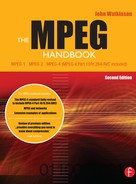Contents
Chapter 1 Introduction to compression
1.2 Why compression is necessary
1.3 MPEG-1, 2, 4 and H.264 contrasted
1.4 Some applications of compression
1.5 Lossless and perceptive coding
1.7.3 Introduction to motion compensation
1.7.4 Film-originated video compression
1.9 MPEG-2: Profiles and Levels
1.11 Introduction to H.264 (AVC)
1.15 Compression pre-processing
2.8 Choice of audio sampling rate
2.14 Introduction to digital processing
Chapter 3 Processing for compression
3.8 The quadrature mirror filter
3.9 Filtering for video noise reduction
3.13 The discrete cosine transform (DCT)
3.15 The importance of motion compensation
3.16 Motion-estimation techniques
3.17 Motion-compensated displays
3.18 Camera-shake compensation
3.19 Motion-compensated de-interlacing
3.20 Compression and requantizing
4.16 Audio compression formats
4.18 MPEG Layer I audio coding
4.19 MPEG Layer II audio coding
4.20 MPEG Layer III audio coding
4.21 MPEG-2 – advanced audio coding
4.25 Compression in stereo and surround sound
Chapter 5 MPEG video compression
5.6 Progressive or interlaced scan?
5.7 Spatial and temporal redundancy in MPEG
5.12 Intra-coding in MPEG-1 and MPEG-2
5.15 Handling interlaced pictures
5.25 Two-dimensional mesh coding
5.27 Wavelet-based compression
5.28 Three-dimensional mesh coding
5.31 Advanced Video Coding (AVC)
5.32 Motion compensation in AVC
6.5 Program Specific Information (PSI)
7.3 Digital television broadcasting
